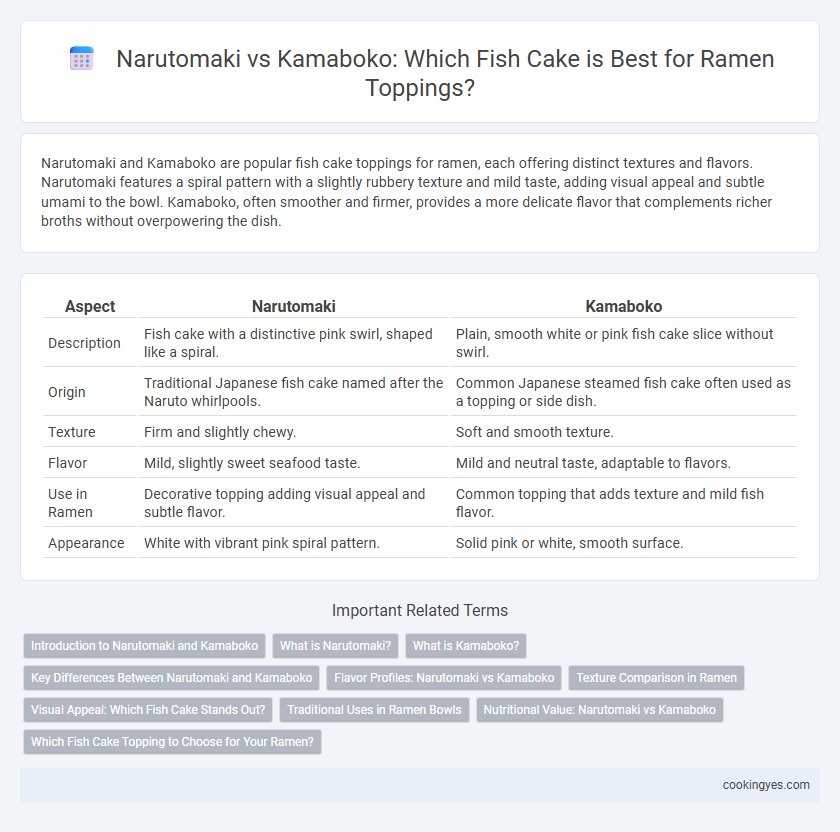Narutomaki and Kamaboko are popular fish cake toppings for ramen, each offering distinct textures and flavors. Narutomaki features a spiral pattern with a slightly rubbery texture and mild taste, adding visual appeal and subtle umami to the bowl. Kamaboko, often smoother and firmer, provides a more delicate flavor that complements richer broths without overpowering the dish.
Table of Comparison
| Aspect | Narutomaki | Kamaboko |
|---|---|---|
| Description | Fish cake with a distinctive pink swirl, shaped like a spiral. | Plain, smooth white or pink fish cake slice without swirl. |
| Origin | Traditional Japanese fish cake named after the Naruto whirlpools. | Common Japanese steamed fish cake often used as a topping or side dish. |
| Texture | Firm and slightly chewy. | Soft and smooth texture. |
| Flavor | Mild, slightly sweet seafood taste. | Mild and neutral taste, adaptable to flavors. |
| Use in Ramen | Decorative topping adding visual appeal and subtle flavor. | Common topping that adds texture and mild fish flavor. |
| Appearance | White with vibrant pink spiral pattern. | Solid pink or white, smooth surface. |
Introduction to Narutomaki and Kamaboko
Narutomaki and kamaboko are traditional Japanese fish cakes commonly used as toppings in ramen. Narutomaki is characterized by its distinctive pink spiral pattern and a slightly chewy texture, often adding a visual appeal and subtle flavor to ramen bowls. Kamaboko, typically white or pink without patterns, offers a firmer texture and mild taste, making it a versatile ingredient in various Japanese dishes including ramen.
What is Narutomaki?
Narutomaki is a type of Japanese fish cake characterized by its distinctive pink spiral pattern, often used as a topping in ramen dishes. It is made from pureed white fish, seasoned and steamed to achieve a firm texture and visually appealing design. Compared to kamaboko, which is a broader category of steamed fish cakes usually plain or with simple topping, narutomaki adds unique flavor and aesthetic value to ramen bowls.
What is Kamaboko?
Kamaboko is a traditional Japanese fish cake made from pureed white fish, seasoned and steamed into a dense, smooth loaf, commonly sliced for use as a ramen topping. Unlike narutomaki, which features a distinctive pink swirl and a slightly chewy texture, kamaboko has a uniform white appearance and a mild, subtle flavor that complements the rich broth of ramen. Its versatility and delicate taste make kamaboko a popular choice for enhancing both the visual appeal and umami profile of various ramen dishes.
Key Differences Between Narutomaki and Kamaboko
Narutomaki features a distinctive pink swirl pattern and cylindrical shape, while Kamaboko is typically a smooth, semi-cylindrical loaf without swirls. Narutomaki's texture is slightly firmer and chewier compared to the softer, more delicate texture of Kamaboko. Both are made from pureed white fish, but Narutomaki is often used specifically as a ramen topping due to its visual appeal and bite-sized slices.
Flavor Profiles: Narutomaki vs Kamaboko
Narutomaki offers a mild, slightly sweet flavor with a tender, chewy texture and distinctive pink swirl that adds visual appeal to ramen bowls. Kamaboko, in contrast, has a firmer texture with a subtle umami taste and often comes in plain white or pink varieties, providing a more neutral fish flavor. Both fish cakes enhance ramen but narutomaki contributes a playful appearance while kamaboko delivers a straightforward, clean taste.
Texture Comparison in Ramen
Narutomaki features a firm, slightly chewy texture that adds a subtle bite to ramen, enhancing the overall mouthfeel without overpowering other ingredients. Kamaboko offers a smoother, more tender consistency that blends seamlessly into the broth, providing a delicate contrast to noodles and toppings. The choice between narutomaki and kamaboko depends on desired texture balance, with narutomaki contributing a pronounced chew and kamaboko delivering softness.
Visual Appeal: Which Fish Cake Stands Out?
Narutomaki features a distinctive pink swirl pattern that creates a striking contrast against the broth, making it easily recognizable and visually captivating as a ramen topping. Kamaboko, typically solid white or pink, offers a more subtle and uniform appearance that blends smoothly with other ingredients. The vibrant, spiraled design of narutomaki ultimately stands out, enhancing the ramen's visual appeal with its iconic and decorative look.
Traditional Uses in Ramen Bowls
Narutomaki and Kamaboko are traditional fish cake toppings commonly used in ramen bowls, each bringing distinct textures and visual appeal. Narutomaki features a characteristic pink swirl, traditionally symbolizing the Naruto whirlpools and adding both color and a chewy texture to shoyu or miso ramen. Kamaboko, often plain white or pink, is typically sliced thicker and provides a milder flavor, enhancing tonkotsu and shio ramen with its smooth, delicate taste.
Nutritional Value: Narutomaki vs Kamaboko
Narutomaki and kamaboko are both traditional Japanese fish cakes used as ramen toppings, but they differ slightly in nutritional value. Narutomaki typically contains a higher amount of carbohydrates due to its decorative pink swirl, while kamaboko offers a leaner protein content with fewer calories and less fat. Both are low in calories and rich in protein, making them nutritious choices for enhancing ramen without adding excessive calories or unhealthy fats.
Which Fish Cake Topping to Choose for Your Ramen?
Narutomaki and Kamaboko are both traditional Japanese fish cake toppings that enhance ramen with distinct flavors and textures. Narutomaki features a spiral pink pattern and a slightly chewy texture, adding visual appeal and a mild fish taste, while Kamaboko offers a smoother, denser texture with a subtle sweetness that blends seamlessly into the broth. Choosing between the two depends on whether you prefer a more decorative and slightly bouncy topping or a classic, tender fish cake that complements the soup's umami profile.
Narutomaki vs Kamaboko for fish cake topping Infographic

 cookingyes.com
cookingyes.com